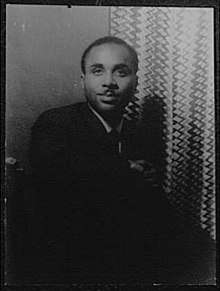Roy Eaton
Roy Eaton (born May 14, 1930) is an American pianist and advertising creative. He is cited as the first black American prominent in the field of advertising.[1]

Photo by Carl Van Vechten
Life
The son of Jamaican immigrants, Eaton grew up in Harlem.[1] His father was a mechanic and his mother a domestic servant.[2] He took up classical piano when he was six[2] and shortly after, in 1937, played at Carnegie Hall, winning gold medal in a Music Education League competition.[3] In June 1950, he won the first Kosciuszko Foundation Chopin Award. He made his concert debut with the Chicago Symphony Orchestra performing Chopin’s F Minor Concerto under George Schick in 1951. He was reengaged to perform Beethoven’s 4th the following season, and also made his New York Town Hall debut in 1952.[3]
His education included the City College of New York, the Manhattan School of Music, the University of Zurich, and Yale; he subsequently became a music instructor at the Manhattan School of Music.[2]
He was drafted for two years into the U.S. Army at the time of the Korean War, serving all of that time in a hospital radio station,WFDH in Fort Dix, NJ where he wrote and produced radio and TV programs.[1]
In 1955, on leaving the Army, Eaton was taken on as a copywriter and composer at Young & Rubicam, and in his first two years created 75% of all the music produced there.[1] In 1957, physicians gave him a 10 percent chance of surviving an automobile accident in Utah that left him comatose and killed his wife of under one year.[2][1] He worked almost three decades in advertising, with Young & Rubicam, Benton & Bowles and later his own company, Roy Eaton Music Inc.[2]
In 1986, he returned to regular concert performance at Alice Tully Hall, in Lincoln Center with a unique program format, "The Meditative Chopin", a subsequent "The Meditative Chopin II" in 1987 and a third recital in the same hall in 1992. Eaton is a long-time practitioner of Transcendental Meditation.[2] Beginning in 1968. He was inducted into the Advertising Hall of Fame in 2010. After suffering a stroke in 2017, Roy has continued to perform.
References
- Edwards, Geoff. "Black History Month: an interview with Roy Eaton". Archived from the original on April 22, 2012. Retrieved 3 July 2014.
- Seida, Linda. "Artist Biography". Archived from the original on 2014-07-03. Retrieved 3 July 2014.
- "Roy Eaton". Retrieved 3 July 2014.